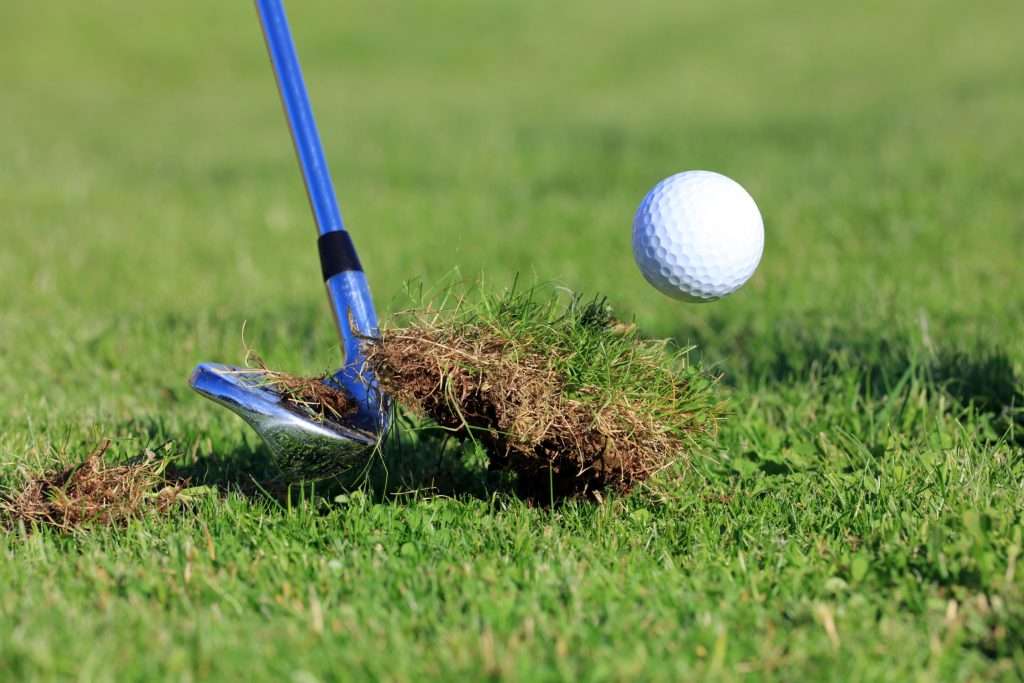Oh, the golfer’s pursuit of perfection. Twenty years in, I often feel as though I’ve been sent on some thrilling quest – hardship and pain aplenty – to up my game. First time breaking 80? Defeating that beast, Bethpage Black’s 15th, with an up-and-down par? First ace? Each breakthrough feels like a leveling up of sorts – a rite of passage through fire and fescue – as I find myself on the odyssey to improve.
Golfers of all skills are on this journey. We want to know everything there is to know about golf. We spend countless hours looking up drills, mimicking swing techniques from the pros and seeking out the best equipment on the market.
As I developed my game for the NCAA stage, I learned the importance of course management and the advantage of having an arsenal of shots at the ready. One such shot that has become a favorite of mine to break out is the flop shot. A handy play to have in the bag for around the greens, the flop shot is the ultimate show of prowess in one’s short game. No matter your experience level, here’s everything you need to know about the flop shot so that you can pull it off like a pro, too.
What is a Flop Shot?
Also called lob shots, the flop shot is characterized by Golf Digest as a “high-lofted pitch—where the ball goes straight up, hangs in the air and lands dead.”
Flop shots are typically executed around the green in situations when there is little green for a player to work with from their angle to the pin (a.k.a. getting short-sided), or when the greens are slippery and a lower trajectory pitch just won’t cut it. They range anywhere between 10 and 30 yards in distance. They are riskier shots to execute because of the finesse they require, but when done correctly can stop the ball on a dime near the cup.
Checking if Your Lie Is Flop Shot Ready
As fun as flop shots are to hit, make sure your lie is favorable before making this play (cue course management). That means that the ball should be sitting high on top of the rough, not embedded where it’s hardly visible; additionally, attempting a flop shot on fairway or first-cut grass is dicey since there’s little grass propping up the ball; this makes it difficult to get the club underneath and may lead to an s-word that shall remain unnamed.
Course conditions also factor in. Rain creates damp, muddy earth that catches the club and causes chunks. Water droplets also weigh down grass and can affect how the ball comes off the clubhead. Days with high winds? Since the flop shot has a high trajectory and high spin, the ball can be caught in unpredictable gusts which can compromise the shot.

However, hitting a successful flop isn’t impossible with poor lies or weather. As your confidence grows in practice, test out your skills on tighter lies around the green.
The Right Wedge for a Flop Shot
Higher-lofted wedges are going to be your friend for traditional flop shots (think: fluffy lies). Like how bunker shots utilize a sand wedge- whose loft is between 54° and 58°- in order to sweep the sand underneath the ball and gently fly it out of the trap, flop shots also require lofted wedges. Aim for a wedge with at least 56° of loft or higher.
The bounce of the wedge also plays a factor. Bounce is “the angle created between the leading edge and the lowest point of the sole or trailing edge.” It prevents the club from digging and catching into the ground at impact – the last thing a golfer wants for a bunker or flop shot. For lies in the rough, a higher bounce (10° or higher) allows you to get the desired height. Those comfortable hitting off tighter lies might opt for a wedge with lower bounce (4° to 6°) to pick the ball clean off sparse lies. Mid-bounce wedges (7° to 10°) are a safe bet for most players to get the best of both worlds.
I recommend getting fitted to find which mix best suits your bag.
How to Hit a Flop Shot
Flop shots are similar to bunker shots in their execution. Not only are lofted wedges used for both, but the technique is nearly identical.
First, start by opening the clubface. Open the face before gripping the club.
Widen your stance and lower your hands.
Keep your weight evenly distributed between both feet. (For tighter lies, you want to put your weight forward. If your weight is too far forward for a standard lie in the rough, though, you risk coming clean underneath the ball.)
Make an easy, 75% backswing. On the downswing, feel as though your hands get to the ball first. Your wrists should easily snap on the downward transition. The weight of this moves the clubhead underneath the ball and pops it up.
Voila! Watch a beautiful, high flop shot dip delicately into your landing zone. Perfect practice makes perfect, so make sure your fundamentals are there as you become more familiar with the shot.
The length of the shot correlates with how open the face is. To hit flop shots shorter (if you have less room to work with), open the clubface more. Conversely, to get more distance, close the clubface a touch (it should still be open at address). Tweak your clubhead setup and swing speed to find your sweet spot.
Practice Drills and Tips
Golf Channel Academy coach, Kelley Brooke, offers helpful tips to practice flop shots. “It’s similar to skipping a ball across a lake,” says Brooke. Along with the proper stance and setup mentioned earlier, you want your wrists to have an elasticity to them, mimicking the natural release of a throw.
To try Brooke’s drill, tee a ball up about an inch off the ground. She uses a brush tee for the purpose of feel in this drill. Focus on sliding the club underneath the ball. You will get immediate feedback if you are on track or not; if you incorrectly catch both ball and tee, you’ll produce a low skull across the green. The goal is to sweep just the tee out so that the ball simply drops in its absence. It’s also helpful to choose a target pin in practice and visualize your shot shape. Check out the full Golf Channel Academy video here for a visual.
Tour Stats and Tiger’s Flops
Year upon year of PGA Tour stats proves a testament to how important a good short game is. In 2022, the top 25% of earners on Tour averaged 9.2 total strokes gained around the green throughout the season. The other 75% of the money list, for comparison, averaged a loss of -0.65 strokes.
Being able to pull off shots under pressure to save par or better is the difference between paydays (or for me, some friendly bets).
Plus, to become an expert in any field requires a range of versatility. It never hurts to learn new techniques that can give you more options on the course. Take Tiger, for instance. He’s a wizard around the greens and it shows in his impressive career on Tour – 82 wins and counting.
Never does Tiger shy away from a shot and the lob shot is no exception. Tiger won the Memorial Open at Muirfield back in 2012 – and a flop shot made the difference. Tournament host, Jack Nicklaus, called it “the gutsiest, best shot I’ve ever seen in golf.” On the 16th hole that final round, Woods missed the green and boy, did he miss it. Submerged in unforgiving rough, facing a green that was running away from him and with water just beyond, Tiger hit a magical flop that landed softly on the green and trickled down. Most would have been happy just to keep it on the green. Tiger holed it. Two holes later, he was hoisting up the Memorial trophy.
Despite numerous back injuries and surgeries forcing Woods to spend time away from competition, each return indeed reminds us how masterful he is with his short game. Incorporating those types of scenarios into your practice sessions can set you up for some adrenaline-pumping moments of glory, too.
Practicality
Flop shots are not only useful, but they’re fun. When I played in the New York State Championship back during my high school days, I remember a longer par 3 where I missed the green right. I had a wide bunker in between me and the green and the pin was placed mere feet off the fringe. I pulled out my 60° and hit a soft flop over the bunker. The ball landed onto the fringe and trickled a few feet from the cup and I managed to scrounge up par. I personally love to hit flops in practice and when I’m feeling fearless in competition.
There’s also trick shots, of course. I wouldn’t dream of attempting a flop shot with any club over a 56°, but PGA pro Jon Rahm has no issue hitting his 4-iron. I repeat, his 4-iron. On Callaway’s Instagram, Rahm can be seen effortlessly flopping the ball over the head of Phil Mickelson – well, his cardboard cutout. Who knows, maybe viral flop shots are on the rise? I personally think #FlopItLikeItsHot could be the next golf Tiktok trend, but that’s just me.
Final Flop Shot Say
Who doesn’t love expanding their golfing repertoire? Who doesn’t love a good flop shot? Be sure to test out these techniques and drills the next time you hit the practice area. And if you pull off a flop shot with the fabled 4-iron, be sure to let us know!


